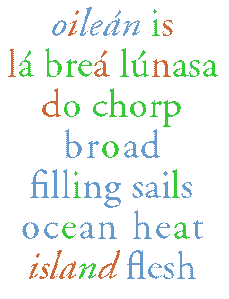one possible ‘frozen & painted’
representation of
I N D R A ’ S : N E T
a cybertextual project by
John Cayley
a work from :
: o r :
H O L O G O G R A P H Y

‘Oisleánd’ was commissioned as one contribution to a touring exhibition of visual art / craft engagements with poetic writing entitled ‘Words Revealed’. (The exhibition opened at the Midlands Art Centre, Birmingham, UK, May 1996.) Apart from its visual content, the exhibition was developed around a focus on writing in Irish, or by Irish writers in English.
This particular commission became part of John Cayley’s continuing cybertextual project, ‘Indra’s Net’. It is the ninth published piece in this series.
‘Oisleánd’ is an exploration of the translation and transformation of one written language into another. In its cybertextual form (as computer software encoding a literary object — specifically a HyperCard stack and graphics files which you may download as shareware from the Indra’s Net Download Point) it uses mesostic techniques to sow the text of either original or translation within the spelt words of the parallel text in its corresponding language. The centrepieces of this cybertextual version of ‘Oisleánd’ are two ‘performance readings’ — English-in-Irish and Irish-in-English. During these ‘performances’ computer software generates new, unique, indeterminate texts according to rules, constraints and chance procedures which are designed and coded by the author.
The ‘performance readings’ of ‘Oisleánd’ are mesostic (internal-acrostic) hologograms with collocational constraints.
They result from applying procedures to two given texts — Nuala Ní Dhomhnaill’s original Irish poem, ‘Oileán’ and an adapted English translation of this poem, ‘Island’.
During any particular reading, one or other of these ‘given’ texts is seen as a succession of the twenty-six roman letters, ignoring punctuation, accents, etc.
The transformation takes each of the letters of the given text in turn, and replaces this letter (which is emboldened in the display) by any word from from the corresponding text in the other language. A further rule is then applied to the result. If it is possible to find a word which satisfies this mesostic rule, and which makes a proper conjunction of words which is natural to the language, then this is always preferred.
Effectively, new texts are generated which are either composed of Irish words picked from a text which slowly spells out the letters of its own translation into English — English (hidden) in Irish — or of English words picked from a text which slowly spells out the letters of the original Irish poem which inspired it — Irish (hidden) in English.
It is easier to see what happens than to try and explain it in prose.
The full cybertextual version would take Java-like technology to implement on the World Wide Web and, as yet, Indra’s Net does not have the resources to join that particular revolution. Instead, you may explore a set of ‘Frozen & Painted Readings’ — colour screen shots which capture and make clear the principles involved, although they show only one static (frozen) reading, not the indeterminate textuality which is the true potential of cybertext.
From the text of the poem or its translation (below), you may link to the screenshots (19 of Irish-in-English, accessible from ‘Island’; and 21 of English-in-Irish, from ‘Oileán’) by clicking on the ‘bars’ (|) to the left of each verse.